South Ostrobothnian two-row accordion playing
| South Ostrobothnian two-row accordion playing | ||||
|---|---|---|---|---|
|
Practitioners and people who know the tradition well
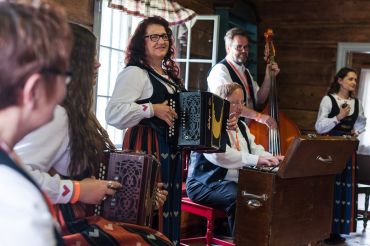
The accordion has had a central role in Finnish and especially in South Ostrobothnian music culture since the early 20th century. It is known as the 'kaksirivinen haitari' or two-row accordion, a popular instrument, particularly in the South Ostrobothnia region. While the accordion is played throughout Finland, the repertoire played on it is largely based on folk melodies documented in the South Ostrobothnia region. The tradition of playing the two-row accordion in South Ostrobothnia is a living heritage. Practitioners of this tradition include both professional musicians and hobbyists. The region is home to numerous master accordionists, performance groups, instrument makers, and educators. Accordion players of all ages participate, ranging from children to retirees. There are several ensembles across South Ostrobothnia. Strongholds of this tradition include Alavus and its smaller villages such as Sapsalampi and Sydänmaa, the Jalasjärvi region (now part of the Kurikka sub-region), Kuortane region, Seinäjoki region, Peräseinäjoki region (now part of the Seinäjoki sub-region), and the Laihia region. Large accordion orchestras are a characteristic feature of two-row accordion music, with multiple players performing simultaneously. These ensembles are organized and foster a sense of community, actively arranging joint performances and events. Some of these groups have established their own associations, such as the Alavuden kaksiriviset ry and Seinäjoen kaksiriviset ry. Other well-known two-row accordion bands include Tepot, Usko Välimäki & Uskos Pois, Ronuuttajat, Sakalaiskat, Kiharakolmio, Haka, 5/5, Enkel, and MäSä-duo. Among the living tradition bearers, several have received the title of master folk musician for their skill in playing the two-row accordion, including Airi Hautamäki, Usko Välimäki, Teijo and Teppo Aho, Teppo Alajuntti, Teppo Välimäki, Risto Ala-Ikkelä, Ritva Talvitie, and Antti Hosioja. They have all contributed to preserving the tradition through performances and education. In South Ostrobothnia, the two-row accordion is considered an important local tradition not only by musicians but also by others in the region. Accordion music is strongly intertwined with the regional identity and plays a significant role in the cultural identity of the province. Community collages offer year-round courses in two-row accordion playing, including at the Lakeudenportti kansalaisopisto in Alavus, as well as in Seinäjoki and Kurikka. Performers are a familiar sight at regional events, revitalizing the cultural heritage of the area by organizing various events, concerts, and folk music competitions.
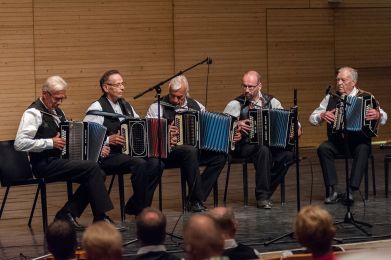
The most prominent organization behind South Ostrobothnian folk music and the two-row accordion is the 'Eteläpohjalaiset Spelit Kansanmusiikkiyhdistys ry' (abbreviated as Spelit ry). The association's purpose is to preserve and develop Finnish folk music and folk dance activities based on the cultural heritage of South Ostrobothnia. To achieve this goal, Spelit ry annually organizes the national and internationally flavored folk music event 'Eteläpohjalaiset Spelit.' These celebrations have been held for 50 years in various locations in South Ostrobothnia and Ostrobothnia. Additionally, Spelit ry collaborates with numerous member-organized folk music events within its operational area.
Practising of the tradition
The repertoire played on the accordion and the folk playing style have been part of a continuous folk tradition for over a century. The South Ostrobothnian melodies and playing style are widely recognized in the field of folk music, and new melodies are also created by the players themselves. Playing the two-row accordion preserves the folk music of the region and the playing styles of old master musicians. Central to the repertoire are old dance tunes such as polkas, jenkas, sottiisis, polskas, waltzes, and masurkas. Traditional aural learning has always been the foundation of two-row accordion playing. The South Ostrobothnian playing style is characterized by a robust approach and a danceable rhythm. Through aural learning, the tunes are still played in the same style as the old masters did. Two-row accordion players uphold their region's tradition not only through folk tunes but also by wearing folk costumes and national costumes as an essential part of their performances.
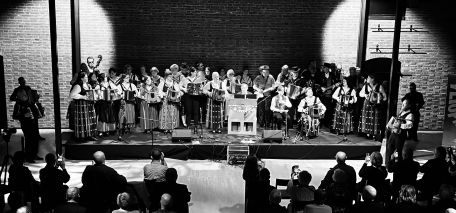
The two-row diatonic accordion has two vertical rows of buttons on the treble side. One row of buttons is typically tuned to the notes of a diatonic, seven-note scale. Different notes are produced when the same button is pressed while pushing or pulling the bellows. In addition to the two-row accordion, the same family of instruments includes one-row and three-row accordion models, which also feature a diatonic button system. Over the years, the accordion has been given various names, such as 'kurttu,' 'pussipeli,' 'hanuri,' or 'pirunkeuhko.' The term 'vähärivinen' (low row) is commonly used to refer to the two-row accordion, indicating its relatively small number of rows. Two-row accordion playing is practiced year-round in various settings, including folk music groups, larger ensembles, or by individual folk musicians. Groups and ensembles meet either independently by the musicians themselves or in weekly study groups organized by civic colleges, workers' institutes, and youth clubs. Instruction in two-row accordion playing is provided locally and nationally at various educational levels, including music schools, conservatories, universities of applied sciences, and universities. Playing in community college groups is community-oriented, aiming to preserve traditional folk melodies played on folk instruments specific to the region and to enjoy making music together. Anyone interested is welcome to join these groups. Group activities include performances at folk music and folk dance events, cultural events organized by cities and municipalities, as well as concerts and evening events organized by the groups themselves. One of the most well-known events is 'Eteläpohjalaiset Spelit' which has been organized continuously for 50 years in different municipalities of South Ostrobothnia. 'Eteläpohjalaiset Spelit' has been one of the most significant folk music events in the region and, more broadly, in our country. In connection with the 'Spelit' event, the 'Spelimestaruuskilpailut' (Spelit Championship Competition) gathers the best two-row accordion players each year. The most important local event is the 'Kevättä palkeissa' concert and 'Pelimannien parhaat' folk music competition held in Alavus, which has been organized continuously since the 1990s. One of the key accordion instructors in South Ostrobothnia is Airi Hautamäki, a master folk musician and director musices from Alavus (born in 1949), who has been teaching hundreds of students folk music skills by ear since the mid-1980s. Hautamäki is a self-taught musician and educator who has learned and taught tunes by ear. Over the years, she has had teaching groups in 17 different locations, including Alavus, Virrat, Seinäjoki, Kuortane, Ähtäri, Jalasjärvi, and Tampere. Among these groups, the Alavuden kaksiriviset, founded in 1986, is the longest-standing and most renowned. The musical culture in the Alavus region remains lively, with many children and young people participating. Airi's teaching groups have spread widely throughout South Ostrobothnia. Some of her students have pursued education in folk music at the Sibelius Academy, earning master's and doctoral degrees. They have continued and developed Airi's playing style and teaching in their own artistic work, including her students Miia Palomäki, Leija Lautamaja, Riina Sakala, Terhi Puronaho, Lauri Kotamäki, and Antti Paalanen.
The background and history of the tradition
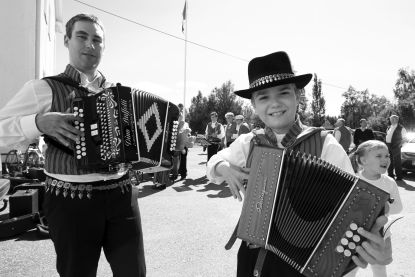
One distinctive feature of South Ostrobothnian accordion music is the tradition of playing one-row and two-row accordions, known colloquially as 'vähärivinen' (low row) accordions, which has been preserved as a living tradition in the region since the early 1900s. According to an article published in the newspaper Pohjalainen, the first markets held in Alavus in 1898 featured a significant presence of accordion players. In the late 1800s, amidst a crowd of a thousand market-goers, there could be dozens of accordion players alongside concertina players. The actual boom of music played on the two-row accordion in the region occurred after the wars. The post-war positive development was primarily fueled by the growing demand for accordion music, driven in large part by the rapidly expanding tradition of evening events. Furthermore, the resurgence of folk music competitions starting in the 1950s, after the wars, inspired numerous accordion players in the region to dust off their one-row and two-row instruments. The popularity of folk music competitions and the desire to excel in them influenced younger generations of musicians to seek private lessons from older master folk musicians. Among the older generation of musicians, notable instructors included Aapeli Hautanen (1899–1984) and Martti Koivumäki (1914–2000) from Jalasjärvi, as well as Veikko Turja (1899–1983) and Urho Myllymäki (1917–1995) from Kauhajoki. Urho Myllymäki is renowned as one of the most significant practitioners of South Ostrobothnian folk music and received the title of 'master folk musician' at the Kaustinen Folk Music Festival in 1971. Aapeli Hautanen, a smallholder and village cobbler, achieved success as a skilled and pure-style player of the one-row and two-row accordion. He learned part of his repertoire from the folk musician Samuel Kujanpää (1879–1965) from Jalasjärvi. Hautanen was named a 'master folk musician' at the Kaustinen Folk Music Festival in 1973. Tauno Krossi (1925–1979) from Laihia is remembered by many festival-goers as a charismatic and tireless folk musician. In addition to performing, Krossi was an active mentor to the younger generation of players. His teaching method was very practical, with tunes learned 'note by note' and 'button by button.' Matti Viitala (1894–) from Kurikka, a painter by profession, was widely known for playing one-row, two-row, and five-row accordions, as well as harmonica and violin. He also composed pieces to be played on the two-row accordion. In the early 20th century, there was a strong period of instrument building in the region when individual instrument makers crafted accordions by hand. One of the most famous was Sameli Elomaa (1889–1967), a wedding musician from Kurikka. After repairing accordions for some time, Elomaa began to manufacture them by hand in his workshop named Kurikan Soitintupa. He built a total of 664 accordions according to the orders he received. Another well-known accordion builder was Antti Viita (1890–1968) from Kauhajoki, whose two-row accordions also had a good reputation. He crafted a total of 74 accordions. Distinct regional stylistic features can be observed in the playing of the two-row accordion. The Alavus region's playing tradition is perhaps the most visible today, with numerous performing groups that have also spread to neighboring areas. In the Jalasjärvi region, the playing traditions of old masters like Aapeli Hautanen and Urho Myllymäki have been excellently continued by master folk musicians Usko Välimäki (b. 1952) and Teppo Välimäki (b. 1947), both known for their virtuosity on the one-row accordion. Usko Välimäki, a one-row accordion expert from Jalasjärvi, which is now part of the city of Kurikka, is an excellent example of a musician who both preserves and innovates the tradition. He adopted the local repertoire and style at an early age, and he has composed numerous pieces of his own. Usko Välimäki began playing at the age of four, following in the footsteps of family members, including his father and grandfather. The research on playing styles by accordion virtuoso Markku Lepistö (b. 1963), originally from Kuortane, started in the 1980s as part of his master's studies at the Sibelius Academy's folk music program. Lepistö's research focused on Kuortane master folk musician Tauno Aho (1914–1996) and his style of playing polkas. Tauno Aho's repertoire and playing style have been faithfully upheld by 'master musicians' Teijo and Teppo Aho, also from Kuortane. Jaana Rinta-Ruona (b. 1964), known for continuing the playing tradition of Laihia and Tauno Krossi's style, has also contributed to the preservation and promotion of South Ostrobothnian folk music. The professional folk music ensemble Tallari, and master musicians Ritva Talvitie and Antti Hosioja, have been highlighting South Ostrobothnian folk musicians and their playing styles for decades.
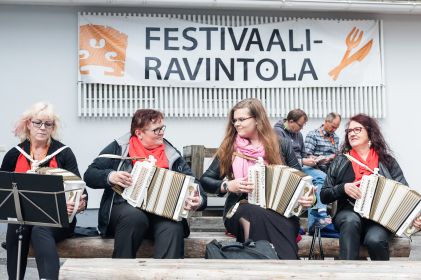
The transmission of the tradition
The repertoire of the two-row accordion includes several hundred memorized melodies, most of which are played by ear, and the repertoire is well-known in the region. Playing the two-row accordion is based on the traditional master-apprentice learning method typical of folk music. The repertoire has been passed down from one generation of folk musicians to another through ear-to-ear playing. The two-row accordion is an instrument with a low learning threshold. Musicians learn the repertoire by listening to and playing alongside other musicians. In the South Ostrobothnia region, numerous two-row accordion ensembles and folk music groups gather, and the music played on the two-row accordion is central to their repertoire. The tradition is passed on as these groups perform at regional folk music events. These ensembles also actively perform both domestically and internationally at various folk music events. Originally, accordion playing played a central role in people's leisure activities, such as barn dances held in the attic during harvest times. Accordion players also played a key role in wedding ceremonies. Musicians in the past learned their repertoire and developed their playing style independently. With the advent of adult education organizations such as community colleges, workers' education institutes, and youth associations offering music education, the tradition began to be practiced and continues to be practiced in various folk music groups and fiddler circles under the guidance of experienced teachers. In folk music competitions, musicians usually perform as soloists and actively prepare for these competitions. Throughout history, folk musicians have had their own showcase pieces, which they perform for judges and the audience during competitions. Competitions also provide an excellent opportunity to learn new songs and playing styles by ear, making them a source of inspiration for playing by ear. During a single weekend, folk musicians may hear dozens of new songs, which they later learn together in community college study groups and practice at home. Two-row accordion groups and ensembles typically meet during the winter months, mainly in weekly study groups organized by community colleges. In addition, active participants organize their own courses and training weekends. Two-row accordion instruction is also offered at the national level in various educational institutions, including music schools, conservatories, universities of applied sciences, and universities. Musicians with professional qualifications continue the tradition by teaching and performing nationally and internationally.
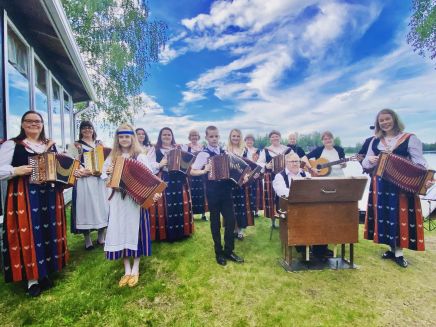
The future of the tradition
The future of the tradition looks promising and secure because it is actively cherished, for example, by training new musicians and performing at various events. Two-row accordion playing in South Ostrobothnia is a renewable and vibrant tradition that evolves and takes on new forms through new compositions and ensemble activities. The number of enthusiasts for two-row accordion playing has remained steady in recent years. Performance groups, associations, and instructors are doing valuable work through their performances and teaching. Several professionals in accordion music from South Ostrobothnia have graduated from the Sibelius Academy. Today's accordion music professionals have created multifaceted and intriguing career paths in folk music and performing arts. South Ostrobothnian accordion music, in its various forms, can be heard all around the world at international festivals, in recordings, and in various productions, thanks to both enthusiasts and professionals. Accordion playing is deeply ingrained in the daily lives and celebrations of many people in the region, taking place at private events and numerous village gatherings. Accordion music is strongly regarded as a part of regional identity in the area and is an important component of the regional identity as well.
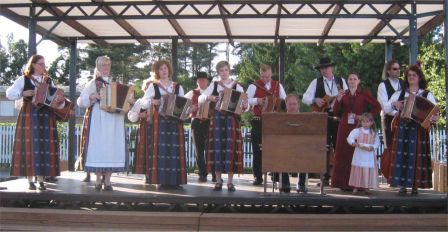
The community/communities behind this submission
Finnish Folk Music Association
Kaustinen Folk Music Institute
Bibliography and links to external sources of information
Videos
Hanuriparaati Kalevan navetassa Seinäjoella 2.10.2022
Alavuden kaksiriviset virtuaalikaustisella 2021
Yle Elävä Arkisto. Ohjelmasta: Mestaripelimannin syysmietteitä. Toimittaja: Mirja Metsola Yle kuvanauha 1977. Luettu 8.6.2022
Yle Elävä Arkisto. Ohjelmasta: Mestaripelimanni Urho Myllymäki. Yle kuvanauha 1972. Luettu 8.6.2022
Yle Elävä Arkisto. Ohjelmasta: Mestaripelimannit eteläpohjalaisten Spelien tähtinä Laihialla 1975. Luettu 8.6.2022
Yle Elävä Arkisto. Ohjelmasta: Haitarissa Veli-Matti Järvenpää, Julkaistu 1989
Usko Välimäki & usko’s Pois soittavat kesäjenkkaa
5/5 yhtye esittää kappaleen Wild Wide Lakeus
Kiharakolmio feat. Lusikkamestari Veikko Kuivala
Markku Lepistö & Leija Lautamaja esittävät kappaleen Balkan Breakfast (Lepistö)
Markku Lepistö esittää kappaleen Lakeuden kutsu (trad.)
Online sources (links checked on 12.10.2023)
Sakala, Riina. Alavuden kaksiriviset, historia. Internet-sivu. Luettu 8.6.2022
Etelä-Pohjanmaan maakunta, wikipedia-artikkeli, luettu 14.6.2022
Harmonikka, wikipedia-artikkeli, luettu 8.6.2022
Urho Myllymäki, wikipedia-artikkeli, luettu 14.6.2022
Tauno Krossi, wikipedia-artikkeli, luettu 9.6.2022
Ilkka-Pohjalainen "Jalasjärveläinen Usko Välimäki on vuoden mestaripelimanni" (11.7.2016)
2-rivisen haitarinsoittajat -Facebook-ryhmä
Web pages for practitioners
Eteläpohjalaiset Spelit Kansanmusiikkiyhdistys ry
Bibliography
Ala-Könni, Erkki 1974: Jalasjärven nuottikirja. Vammalan kirjapaino Oy.
Lepistö, Markku 2016: Markkinarenkuttimesta Martin Pauliin, Harmonikka kansanvalistuksen ja populaarimusiikin Suomessa 1850–1900. Sibelius-Akatemian kansanmusiikkijulkaisuja 26. Taideyliopiston Sibelius-Akatemia 2016.
Lepistö, Markku 2014. Yksi- ja kaksirivisen harmonikan opetus. Teoksessa Vesa Kurkela & Marko Tikka (toim.), Suomalaisen harmonikan historia.Suomen Harmonikkainstituutti & Suomen Harmonikkaliitto, Sastamala.
Kolehmainen, Ilkka 1989: Hanuri suomalaisessa kansanmusiikissa. Kansanmusiikki 3/1989. Kansanmusiikki-instituutti.
Kurkela, Vesa & Tikka, Marko (toim.) 2014. Suomalaisen harmonikan historia. Suomen Harmonikkainstituutti & Suomen Harmonikkaliitto, Sastamala.
Kurkela, Vesa (toim.) 1982. Tutkielmia jalasjärveläisestä haitarinsoitosta. Helsingin yliopiston musiikkitieteen laitoksen julkaisuja 1, Helsinki.
Linqvist, Kalevi 1983. Soitamme yksi- ja kaksirivistä. Kansanmusiikki-instituutti, Kaustinen.
Paalanen, Antti 2015: Palkeen kieli, Vaihtoäänisen haitarin
